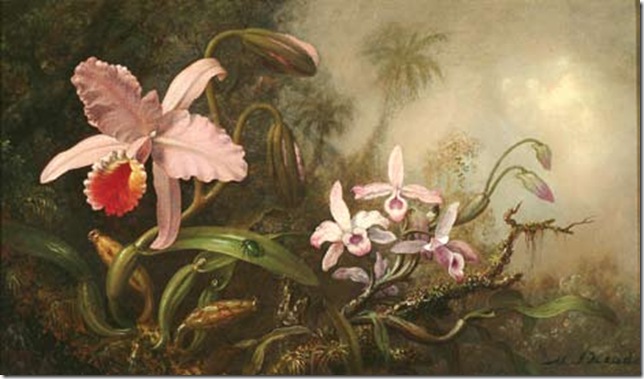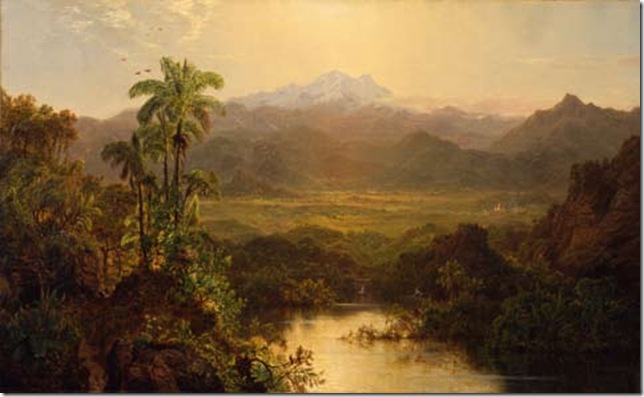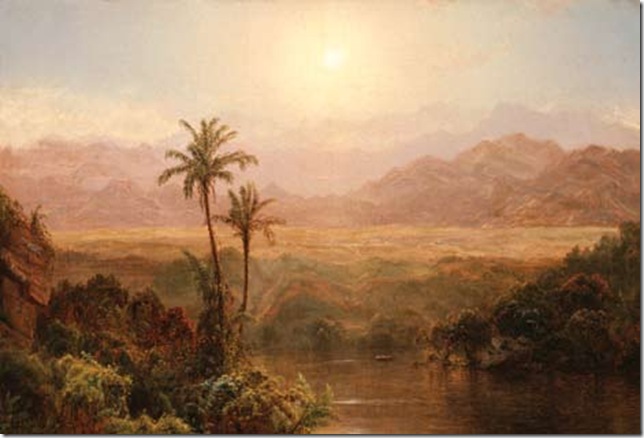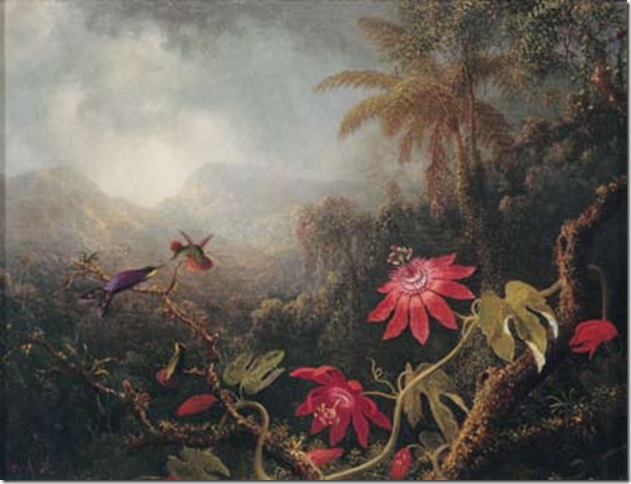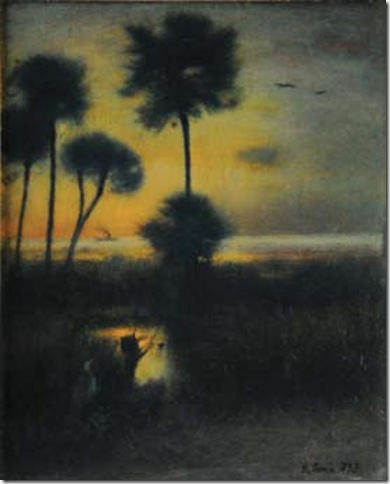A “Wow!” is heard in the first room of the Flagler Museum’s second-floor gallery.
It’s uttered in response to Martin Johnson Heade’s massive The Great Florida Sunset, one of the highlights of the Flagler’s winter show, New World Eden: Artist-Explorers in the American Tropics, running now through April 18. It won’t be the last.
In the mid-19th century, the German explorer Alexander von Humboldt, who had spent years in Central and South America, realized visual artists were needed to capture the raw beauty of the region. This exhibit is the happy reunion of those who responded to his call in very personal ways: Heade, Frederic Edwin Church, John James Audubon, Louis Rémy Mignot, Hermann Herzog and many more.
They came, they saw, they conquered — with the brush. Three rooms comprise the exhibit, each of them a different color: blue, purple and peach.
Not everything in that first blue room needs a pause at the bench.
If one work does, it’s The Great Florida Sunset, the largest painting Heade (1819-1904) ever produced, and commissioned by his friend Henry Flagler for the Ponce de Leon Hotel.
It’s an unusual work because of that simple flat land Heade chose to depict using bold colors and use of light. It’s simple, not dull and specially not devoid of emotions. Other landscape artists turned the eye in search of a more robust, eventful scene as the one captured by Church for In the Andes. It’s less intimate and more idealistic.
Although a scientist, Church (1826-1900) shared von Humboldt’s notion that the tropics was a place touched by the hand of God. His paintings thus reflect the divine without neglecting realism. They show an artist busy with studying the place’s natural history and geological forms.
Before you move on, spend some time with Charles de Wolf Brownell’s Limestone Cliff of Bolondron, Cuba, 1860. That serene multi-color sky seems to have inspired the rooms’ wall color. Brownell, a contemporary of Church and Heade, spent winters in Cuba, where the family owned sugar plantations. It’s not that surprising, therefore, to find natives depicted in this painting.
Right below, an iguana fuses with the environment, just as we would expect in real life and one single white bird is seen flying west. These two singular elements suggest a shift toward the more Darwinian outlook: focus on the individual rather than in the grandiose general vista.
The second room reflects just how strong was the influence of the author of The Origin of Species.
Here it is the hummingbird and orchid works by Heade that steal the show. We find two of the surviving hummingbirds prints he created while in Brazil and for a series he had hoped would capture the birds’ habits and life cycles. He was the first artist to paint them from life and desperately wanted to capture their jewel-like coloring but was apparently unsatisfied with the results he achieved.
Ironically, he exceeds our expectations, for how close can an artist really get to capturing the iridescent color of a live hummingbird? Very close, it turns out. Hummingbirds and Their Nest, an oval painting from 1863, combines a dreamy background with that incredible distinctive color of the bird that fascinated Heade.
![Orchid Brooch, Odontoglossum cervantesii (1889-96), by Tiffany and Co. [designer: George Paulding Farnham] Orchid Brooch, Odontoglossum cervantesii (1889-96), by Tiffany and Co. [designer: George Paulding Farnham]](http://palmbeachartspaper.com/wp-content/uploads/2010/02/orchidbrooch_thumb.jpg) On the right side of the room his paintings get more elaborate. We find his orchids often paired with hummingbirds and beetles. One dramatic example is Large and Small Orchids with a Beetle, in which one big orchid (Cattleya labiata) is pushed to the foreground, to the point we feel we can reach it with our left hand. On the background, the plants yet to bloom appear to be moving. It’s the perfect marriage of reality and imagination.
On the right side of the room his paintings get more elaborate. We find his orchids often paired with hummingbirds and beetles. One dramatic example is Large and Small Orchids with a Beetle, in which one big orchid (Cattleya labiata) is pushed to the foreground, to the point we feel we can reach it with our left hand. On the background, the plants yet to bloom appear to be moving. It’s the perfect marriage of reality and imagination.
Complementing his paintings and Laura Woodward’s watercolor takes on the red hibiscus flower are stuffed hummingbird displays, feather hats, beetle-inspired jewelry, orchid brooches and a sensational orchid vase from Tiffany and Co., which museum curator Tracy Kamerer said took many negotiations to bring to the exhibit.
The objects remind us that art manifests in our life in more than one way. It feeds fashion, literature, politics, religion. It appears in one medium and soon takes over the rest.
More jewelry, rare old books and romantic depictions of wilderness fill the third room of the exhibit. It is here that we find the bold Mignot, the romantic one, with an adorable, warm vision titled Tropical Sunset. In the first room he is seen mirroring his friend and travel partner, Church. One thing Mignot (1831-1870) did differently was to feature human interest elements — bridges, people, paths — in his works.
If Mignot remains obscure, a better-known 19th-century landscape painter who experimented a great deal with light effects and dared to add a personal touch to his work is George Inness (1825-1894). For a work that contains very little action — a lone heron stands to the left– Home of the Heron is surprisingly dreamy, highly mysterious and moody. This is a work to avoid if you feel down, but it’s perfect for the adventurous soul and the meditative one.
While in this room, listen for another loud Wow! This time it belongs to Church: Twilight in the Tropics stands apart not just because of his darker tones but because of that romantic bright moonlight without which, we suspect, we could not see the magnificent vegetation. By now we are used to Church’s daylight tropical vistas and big-picture style. But here he takes a closer look at individual plants and in doing so, a more Darwinian approach.
The intimacy of the painting, suggests an artist more in touch with his own essence or perhaps more devoted than ever to his work. The painting, whose lender is anonymous, actually dates to the time Church spent in Jamaica following the death of his two young sons in 1865.
If you are touched by nature or touched by the art it inspires, this small, sweet exhibit will be worth your time. Plus, it doesn’t take an entire morning or afternoon to introduce you to works so precious that, according to Kamerer, “nobody wants to lend them anymore.”
This year marks the museum’s 50th anniversary and museum organizers wanted to do something simple and close to Flagler. It’s not the exhibit to see if you’re looking for edgy: This is, peaceful, warm, gorgeous; at times wild, but not looking to shock.
Once here, be like one of many natural elements you’ll see depicted. Be water or a flower or a hummingbird. Go with the flow.
Gretel Sarmiento is a freelance writer based in South Florida.
NEW WORLD EDEN: ARTIST-EXPLORERS IN THE AMERICAN TROPICS runs through April 18 at the Flagler Museum on Palm Beach. Admission is free with a ticket to the museum. Adults: $18; $10 for youth ages 13-18; $3 for children ages 6-12; and children under 6 admitted free. For more information, call 561-655-2833 or visit www.flaglermuseum.us.
